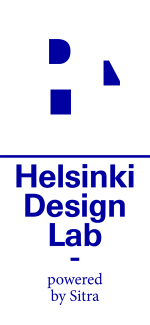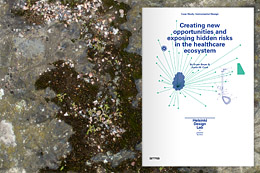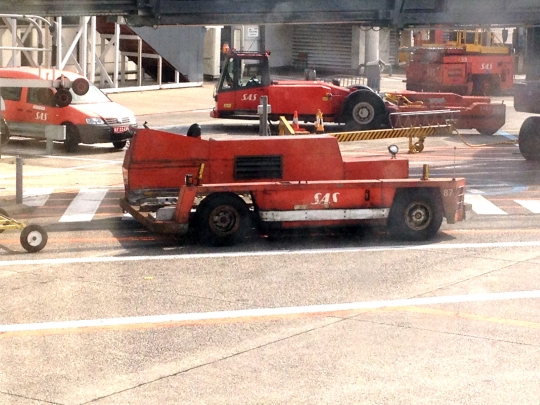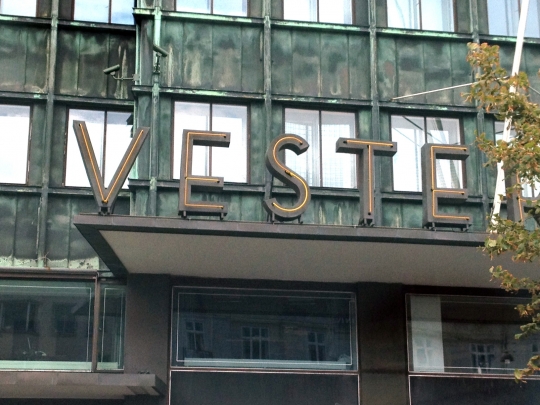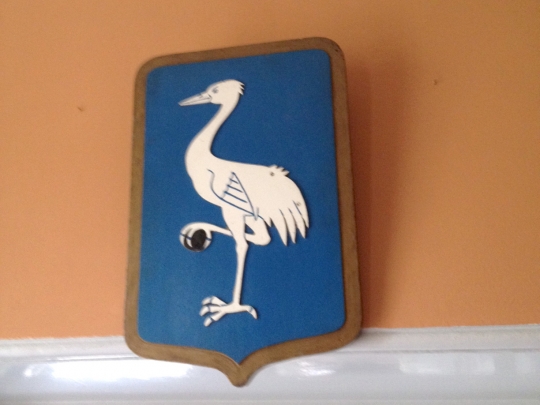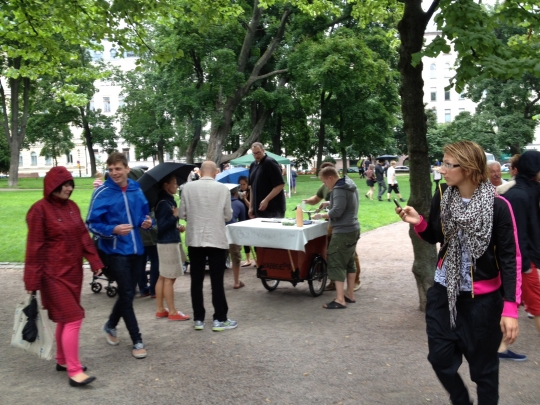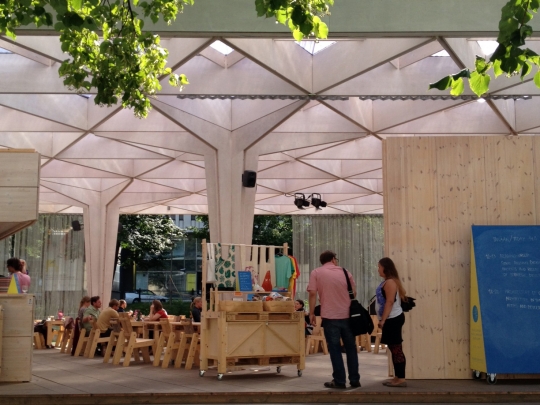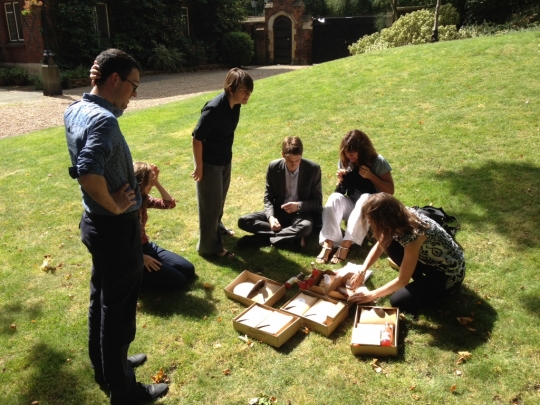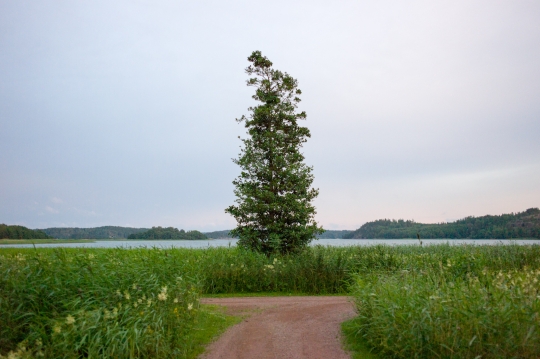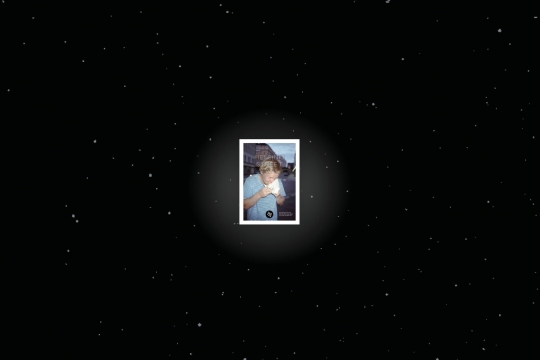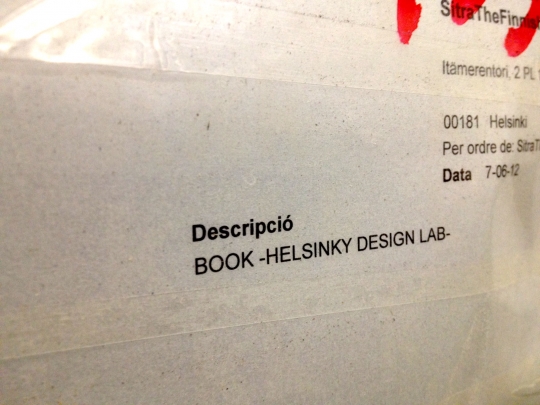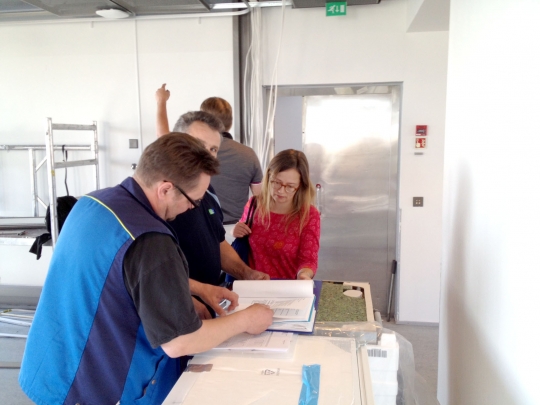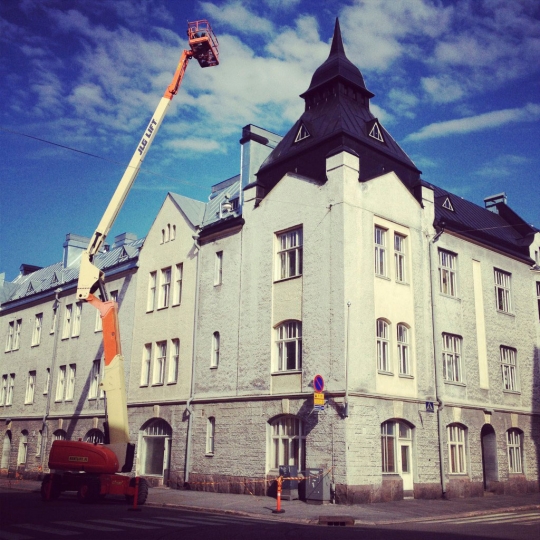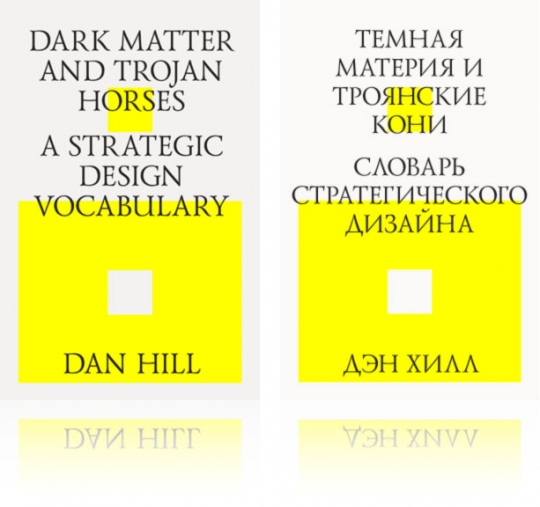Helsinki Design Lab helps government leaders see the "architecture of problems." We assist decision-makers to view challenges from a big-picture perspective, and provide guidance toward more complete solutions that consider all aspects of a problem. Our mission is to advance this way of working—we call it strategic design.
Note: This is cross-posted from Insidejob.fi since it's relevant to readers of the HDL blog too.
Our Design Exchange Programme is growing again. In August we placed Jaana Hyvärinen to work with the City of Helsinki Department of Social Services, where she will focus on integrating service design into the organization’s strategy. While the public sector is improving its service design capability, we also need to build organizations capable of framing relevant questions in the first place. No one wants a fantastically delivered service for something useless, or even harmful. How about the best surgery for those who don’t need it? So this is a wordy way of saying that we see service design as one part of a compliment of approaches to bring coherence to what we say, what we do, and how we do it.

Bryan standing below the Finnish saying “Fear of God is the beginning of wisdom”. DEP is as much about entrepreneurship as it is about culture. Can we build a culture that stems from trust instead of from fear?
Our societies have built great innovation traditions in the private sector, but that entrepreneurship can still be dormant in the public sector. While Helsinki Design Lab is about knowledge creation, capture, and dissemination, DEP was conceived to build capability within the public sector in Finland. Sitra's design-related work balance two sides of the same effort. We reflect on the knowledge and craft of strategic design through HDL, and build practical capabilities through programs like DEP. Public sector entrepreneurship requires both.
We're excited to announce that we now have two more openings for public sector designers, this time working within two Finnish Ministries. One position is open within the Ministry of Employment and the Economy (TEM) and the other within the Ministry of the Environment (YM). Applications for these these one-year positions are closing soon, so take a look at our job posting if you are interested. Please also help us spread the word!
This round of hires will bring our DEP total to four placements. Our gamble was that DEP would be a great learning experience for our embedded designers, for the hosting Public Sector organizations who gain a new capability, and us who get to learn first hand from this experiment. Early indications are positive and we will undoubtedly be examining the questions of whether to build DEP into something beyond this first pilot year.
On the 14th floor of the Sitra tower the view is gray through and through. A fog has set in, obscuring the horizon and veiling not-so-distant Espoo. Autumn has come to rest in Helsinki and we're welcoming the season for its crispness.
This end of the year is a time for being shipshape, and last week that meant launching Open Kitchen. Here's what that's about:
We won't teach you to cook. We teach you the business of food.
Open Kitchen is a programme that demystifies the business of food by creating a forum for you to learn from the city's experienced culinary business people who've been there and done that, and then working with your peers to build and run a prototype restaurant for a week.
Or you can watch Antto, one of Helsinki's most accomplished chefs and restauranteurs, explain it. We're very happy to be working with him, and a slate of other fine people to be announced in the near future. Needless to say, if the idea of learning from Antto and others is appealing to you, and you're located in Helsinki, please apply! You have till October 3rd.
For more on the development of Open Kitchen you can read about how we pivoted from our original idea of establishing a sustianable Grilli towards the current implementation as a sort of dark matter academy.
Maija is busy with Brickstarter, still posting a seemingly endless quantity of fact cards, whilst also working on a set of service journey mappings for self-initiated urbanism. At the macro level, Dan and I are working on the longer term future of the project by refining the scenarios I mentioned last time. That makes it sound more coherent that it is, really. There's a lot of scribbling on paper, sometimes on a whiteboard. More lines than words often.
We spent the first half of last week at MindLab in Copenhagen with Runa, Niels, and Christian, as well as Tom Loosemore and Russell Davies from Government Digital Services, part of the UK Cabinet Office. This was the third and final HDL 2012 case study pairing and it was—like the previous two—a brain-smacking experience. Lots to take in, lots to process. Our challenge is going to be choosing what to focus on with such a wealth of craft knowledge generously shared by MindLab, GDS, and the other case partners.
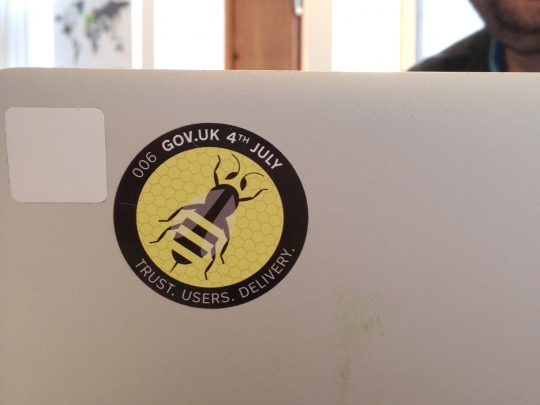
"Mission badges" from GDS. A nice touch of material culture inside their org.
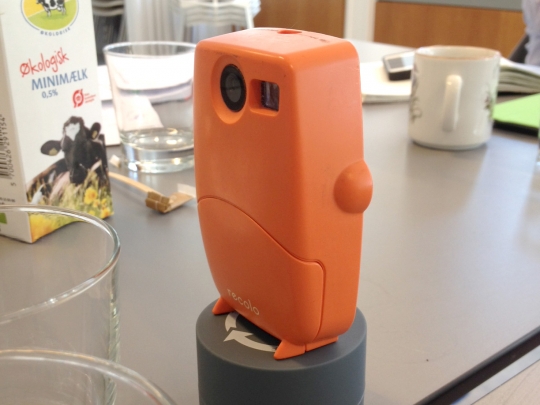
Russell brought a time lapse camera to the meeting.
As with the previous sessions, we looked at one project from each team and left ourselves with a rather wide open agenda so that there would be plenty of room to follow the conversation as it goes. Dan has started collecting his notes from that session. I'll do the same shortly and then we'll have a brainmelt with Marco and Justin to collate the brightest spots from all six projects we've learned about.
Our first pass is via language. What are the words that people use to describe their work? What are the terms that they use, and the meaning they imbue those terms with? This is less of an arbitrary choice than it may seem: one of the threads of consistency that bind the six projects we looked at is that they're all driven by hyper-communicators. People who just really know how to explain things, to share them, and to make them real for others.
HDL 2012 is beginning to consume my calendar, and increasingly eating into others' as well. Maija, Marco, and I spent an afternoon checking logistical details. All is well there, though some items remain outstanding.
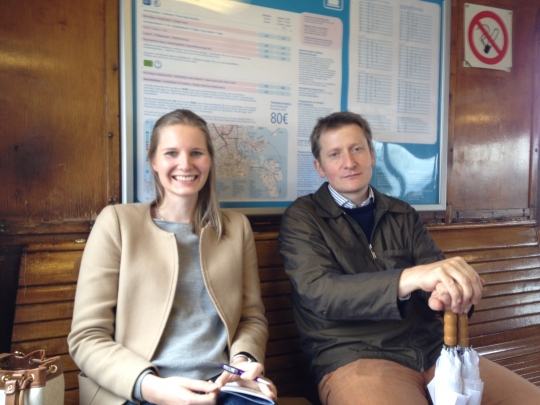
On the boat to scout out locations

Are you the right place for us to have HDL 2012?
The Design Exchange Programme is growing a bit. Jaana Hyvärinen has joined the City of Helsinki Social Services department, where she will be helping build a culture of service design. Sara has a new blog post describing her busy autumn. We should have two more posts open shortly. As ever, we'll post here and on Inside Job when they're live.
Marco has written a blog post on the Low2No site explaining how that project has changed tack a bit. Worth a read if you've been following our work on that one.
And just now the infinite gray outside has broken, giving the Baltic back to us in shades of dirty cobalt. Welcome to Monday.
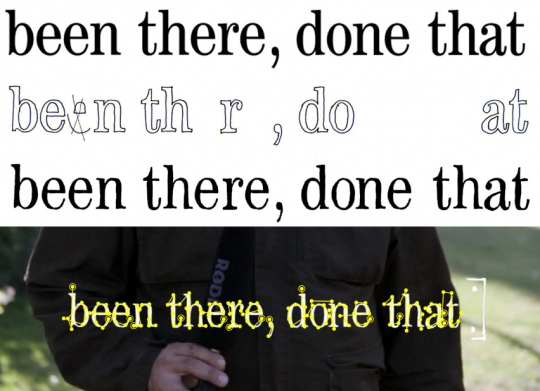
Some scraps from the production process for the Open Kitchen video, included for no other reason than they look nice. Starting from the top: digital text, hand traced text, cloned to fill out the words, and then being animated to write itself onto the screen.
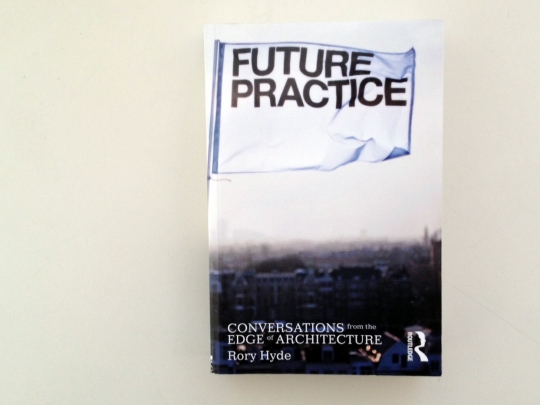
Rory Hyde has written a book about future trajectories for architecture and design practice. Dan wrote the forward and I'm one of the subjects, so we're happy to have Rory in town for a book launch/talk at the Paviljonki tomorrow, Tuesday the 11th at noon.
Last week we finally went live with Open Kitchen. I'll let Antto explain it briefly and if you want more detail you should check the site; this post will focus more on how we ended up with Open Kitchen as a project.
Readers of this blog will know that we like our food, but the motivations for this project go well beyond the desire to get a decent falafel, banh mi, or reindeer sausage in Helsinki. We engage food because we're interested in broadening sustainable consumer choices and fostering social diversity within Finland. Food is a good way to address these topics because it's the original social object. It's a familiar, tangible, and inescapable thing that's deeply tangled in individual preference, shared culture, and dark matter. This is a familiar story, so I wont belabor it. Instead, I'd like to share some of the backstory to the project and use it as an example of the pivot—a play that we've been adapting from the world of startups into our public sector practice.
To plan is to change your business, to pivot is to let your business change you. Despite best efforts to analyze and plan, the world does not always play out according to the script we write for it. In these situations, where you find yourself standing before unexpected opportunity or pitfalls, to pivot is to change the means that you're using to achieve the ends you desire. After a pivot you're headed in a new direction, but still rooted in the same first principles.
One year ago, when we began working on what has now become Open Kitchen, the concept looked like this:
Belly First Sustainability (Food, Public Debate, Business) — Concept Note
We want to accelerate the development of the sustainable food industry and culture in Finland by incubating the Low2No service partnership in anticipation of 2013. The aim is to sell sustainability, one bite at a time.
This is accomplished by building a Sustainable Grilli in Helsinki during the WDC2012 to create an accessible and first-hand entry point to public debate about sustainable lifestyles in Finland. The project is executed in three components: a competition, a temporary food cart business, and an events programme (in Helsinki and other cities) concurrent with the business.
In this draft (from September 15, 2011) you can see that the emphasis is split between providing a platform to prototype part of Low2No and larger systemic change goals around sustainable food. The means we had settled on to achieve this goal was to create and operate a sustainable grilli kioski for the summer.
Between the first conversations Justin and I had about 'belly first sustainability' and writing this concept note, two important things happened: the Camionette and Ravintolapäivä. Both of these unexpected events changed the context of food and food culture in Helsinki, and more importantly they provided tangible evidence of a new group of self-starters. Both involved demonstrations of what that new culture looks like, how it tastes, and how it changes the experience of the city in ways beyond just the foods on offer.
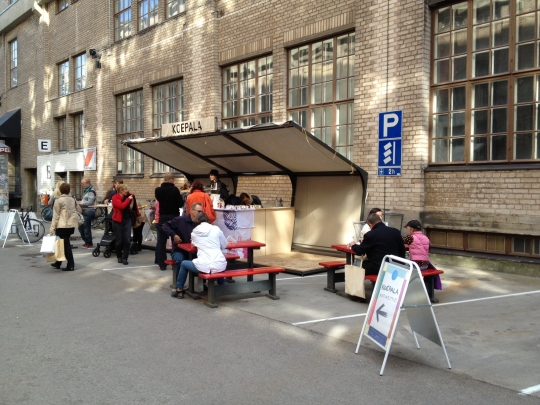
This is a snap of Koepala, a popup during Helsinki Design Week. New food-related concepts are popping up all the time now. Open Kitchen is designed to help them take root.
Both also highlighted problems in public sector decision making. The silos of our regulatory context were not set up to handle initiatives that came in the 'shape' of a food truck or a create-you-own-restaurant festival. The result was some rather public shaming of various public bodies through traditional and social media when those institutions did their normal, conservative thing. To their credit these same organizations responded quickly and positively, but not very coherently.
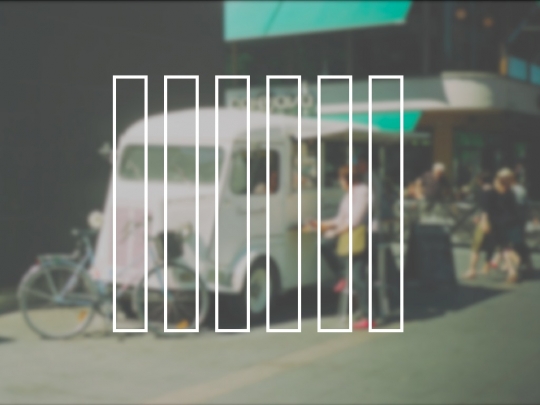
The "shape" of the city's organization doesn't match the interests and experiments of the citizens—here the Camionette. So when something like a food cart first comes along as a question, public bodies can be caught off guard.
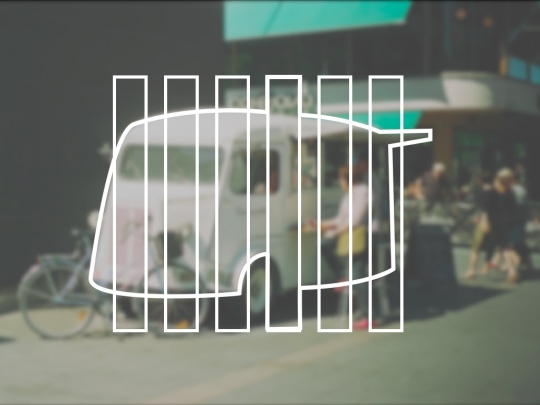
It literally doesn't fit into the silos that the city is organized around.
As we were working the concept note through various parts of the internal machinery of Sitra we were gleefully watching these changes happening on the street. And then something funny happened: we realized that we were developing a project for a world that didn't exist anymore. By the autumn of 2011 Helsinki didn't need a demonstration that sustainable street food was viable. That had been done already by entrepreneurs like Tio Tikka and activists like Olli Sirén.
Yet despite the positive blips that we observed, it remained difficult to get started in sustainable food in Helsinki. There was (and still is) a gap between the effervescent vitality of Restaurant Day and the day after restaurant day, when all of that surplus energy, excitement, and talent subsides back into previous routines. The ladder of innovation is missing some rungs, you might say. Restaurant day is a great way to test out an idea, but for those few who want to go further, where next? What steps exist between a pop-up and taking out a lease on 200 square meters of restaurant real estate?
These missing rungs of the ladder became our focus. We pivoted from a sustainable grilli demonstrating a new food culture, to a dark matter academy that could illuminate the tacit knowledge of sustainable food pioneers in Finland. We want to make it easier to create lasting, thriving sustainable food businesses in Finland. Open Kitchen relies on people who've "been there, done that" to share their knowledge and experience with others.
While this was unfolding we were writing the story, quite literally, in the form of a print-on-demand book. The research that went into the book and early development of the concept led us to meeting people all over the city, from restauranteurs to regulators to politicians, and everyone in between. We wrote it because that was an easy way to send us careening into the thick of things. Rather than sit in Sitra HQ and try to abstractly reason a view of the world, we got out there and started asking people how their corner of it works—or doesn't. Consistent across these meetings was a feeling that there's a good bit of knowledge and experience in the city, but it remains caught in pools—dark pools—within isolated communities.
Amidst our first proper blizzard of the 2011-2012 winter, Dan and I paid a visit to Ville Relander, who heads up Food Strategy for the City of Helsinki, and Elina Forss of Marrot Oy at the newly opened offices of Tukkutori. As we explained our interest in food the conversation fell quickly into a productive rhythm. Marrot, with the support of Ville and others, had been developing Kellohalli as a food culture hub for the city. It was to feature a strong programme of events, a library, and other activities. As strong as the plan was, it still pointed to the missing rungs of the ladder: once people get excited about food, what next? How do you go from enthusiast to entrepreneur?
The idea of the dark matter academy that we had been simmering (sorry!) was suddenly congruent with an opportunity right in front of us, with real names and availability and interest. That was that. In Marrot we had found partners who were already well positioned to help us develop and execute the concept of the dark matter academy for sustainable food. The pivot happened immediately, almost without a thought, because in fact the thinking had already been done and we merely catching up to the full implications of our intentions.
Pivoting can be difficult to accept, especially inside an organization that is used to a linear sequence from scoping to planning to execution to measurement. One of the ways that we try to deal with this is to focus on establishing the first principles of a project early on, revisit them often, and always explain our projects by building upwards from those principles. It leads to a bit of a broken record syndrome, but the best way to make sure the principles of a project are carried with the work itself is to repeat them over and over again—to yourself, and to everyone you're working with. This prepares us to make on-the-spot project decisions based on those principles, to align what we do with what we think, even in the smallest details.
Here, once again, we find that a useful play such as pivoting requires the right culture. Had any of the people in the team been rigidly locked into the grilli as The Thing To Do, or had the internal Sitra procedures rejected the Open Kitchen proposal, the attempt to pivot would have broken the project instead.
In all honesty, writing this weeknote is taking some effort on my behalf. My brain feels sintered to the details of our various projects and stepping back to take stock—let alone reflect upon—the lot of them requires more effort than it should.
But we do this weeknote thing so that we have a sense of history. It's useful to be able to look back and remind ourselves what last week was like, or what was going on one year ago, even how we felt today-minus-104-weeks. We value this sense of perspective, so we push ourselves to write even when there are other things to be done.
First the facts. Dan spoke as part of Nokia's Designed in Finland talk series. Marco was in Copenhagen midweek to give a talk at MindLab. He managed to work diapers into his talk.
I found something new in Helsinki:
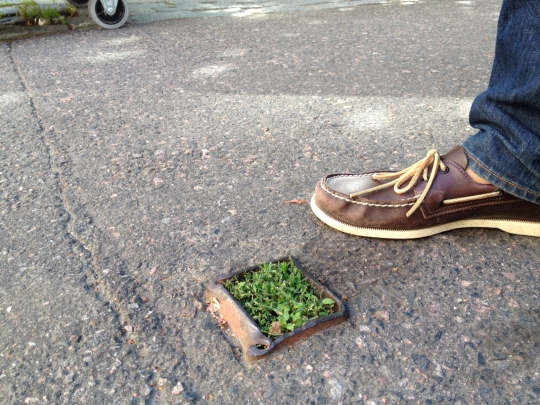
Helsinki's smallest park. A moment of pure joy. No explanation needed and none available.
Speaking of new parks in town, the week's haul of Brickstarter-shaped doings included Dan on the horn with the Guardian, resulting in this excellent article about crowdfunded urbanism including Brickstarter. Maija continues her diligent and careful documentation of other projects that overlap with the Brickstarter conversation. Having worked through all of the examples we could find in Finland, she is now turning her attention to international precedents and analogues. Meanwhile, we've had a few sessions with the larger project team including Erkki and Kali to balance out the portfolio of mini-projects under the Brickstarter umbrella.
Dan tweaked the Brickstarter introduction to make it more clear that we are working towards a prototype or a sketch of the service, and not intending to develop and operate a service ourselves. Attentive readers will remember that last week we were assessing a variety of scenarios for next steps, and that discussion continued this week. We're hoping to have some decisions here sooner rather than later, and when we do it will be easier to be explicit here about where Brickstarter is headed.
Kalle's video editing spilled over into Week 179, but we won't give him a hard time about it since he had never used Final Cut before last week. How's that for a learning curve! We finished a draft of the Open Kitchen call for applicants video and have sent that to Antto and Elina for comments. We're planning to begin accepting applications the week after next and getting the video nailed down is one of the larger outstanding to-dos. Lots of other to-do items before then, including minor things like crossing the tees and dotting the eyes on the wording of the dual language Finnish/English application. Oh, but before that we have to finalize the application process… and write it all up.
On a related note, congratulations are due to friend-of-HDL Cynthia Shanmugalingam and her partners over at Kitchenette. They're just launched a street food incubator programme based in London and we will be following along with great interest.
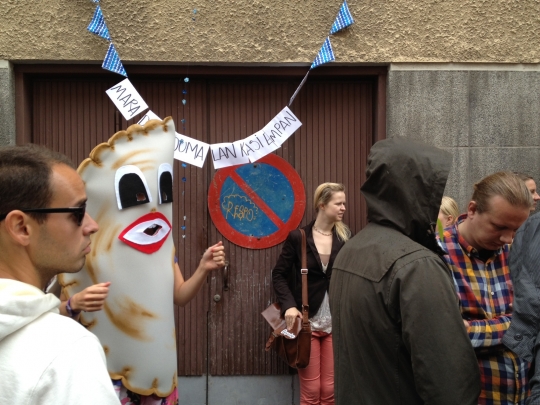
Restaurant Day happened again. Note to would-be amateur restauranteurs: dancing, human-scale versions of your foodstuffs are a surefire way to draw a crowd. Delicious empanadas also help.
Last on the project rundown is HDL 2012. We're operating on a couple different wavelengths at the moment: Dealing with near-term logistics for our third and final case session in Copenhagen next week, beginning to coalesce the content from the four cases we've already heard from, and ramping up the pace on logistical and content development for the culminating session in Helsinki. Venues, printing timelines, writing rotas, invitations, and moments of "why are we doing this?" are in the stew right now. We know why, of course, but we've been revisiting the framing of the discussion—in a healthy way.
My bedside reading list has been forming useful bridges to the daily work including, in particular, this assertion put forth by Richard Sennett in The Craftsmen [sic]:
"We are more likely to fail as craftsmen, I argue, due to our inability to organize obsession than because of our lack of ability."
The best way to rectify that is to organize our obsessions, no? With HDL 2012 we are looking at public sector innovation and trying to codify the crazy.*
*Only those crazy in a good way.
Signing out of my hotel in London today I made the mistake of putting the date down as September. Not yet, Bryan. Not yet. But this calendar mishap does reveal my state of mind. As our projects become more concrete new details emerge. New things to be taken care of, things to be considered, and somethings things to be deliberately ignored. But anyways, a lot to keep track of.
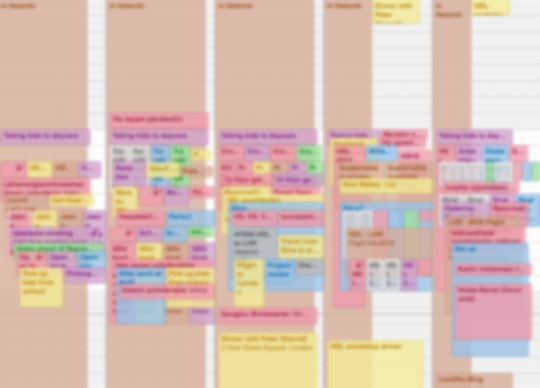
Team calendars are an indication of what our life is like right now
Maija and Kalle have been buzzing around making movies. Maija and another Kalle were shooting a pitch so that we have some plausible content in place when we release the Brickstarter mockups as clickable pages (soon!). Kalle spent an afternoon with Antto Melasniemi in Tukkutori filming the call for applicants video for Open Kitchen. They're both now heads-down editing.
(Aside: we've been watching lots of pitch videos on Kickstarter and elsewhere to learn what makes them effective. This is one of the gems we came across:Informative, unique, and hits exactly the right tone for their audience, one suspects)
Open Kitchen is seeing a smörgåsbord of activity, suitably. We're (still) wrapping up contracts, commissioning work on the brand and logo, booking ad space for the fall, and finalizing the application process so we can open that at the start of September. Elina and Antto have a good feel for most of these, and collaborating with them on the project continues to be a joy.
Although we like to do things in the open, and this project even has "open" in the name, it's kind of nice that there is not much of a public presence for the project just yet. Beyond the book we have not released many details which means we're not having to answer lots of questions. In September we will publish the call and this will change, but we'll be ready.
Brickstarter, on the other hand, has been getting tons of attention. This is all immensely positive, of course, and we've been happy to see interest from across Europe, North America, and elsewhere. Marco, Justin, Dan, and I spent an afternoon out of the office sketching scenarios A through D for Brickstarter (more like A through X).
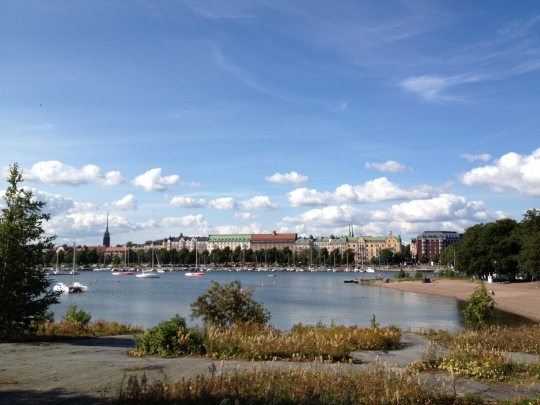
Helsinki doing what it does in summer
As we decide next steps we're balancing scenarios based on our understanding of the needs of citizens and municipal governments, Sitra's abilities, and what sort of interest we can attract from partners and collaborators. Do we build Brickstarter as a running service? If so, who will operate it long term? Do we build half of it and ensure a good handoff to another team? Maybe, but who will that team be? These questions have been part of our dialog since the start but we're approaching a decision point, thus scenarios A through D.
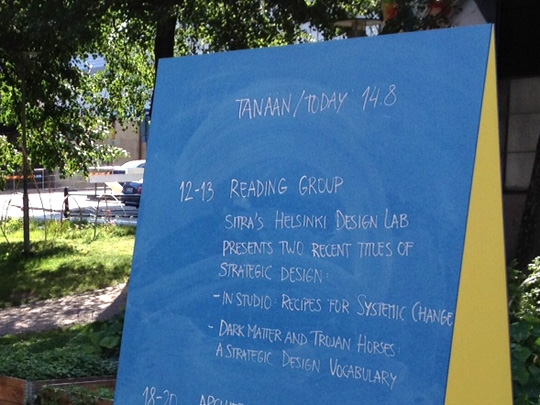
In the middle of the week Dan and I did a book reading at the Paviljonki. Sure is going to be sad to see it close up for good in September.
And then there was London. Marco and I came here under the auspices of HDL 2012 to learn from Nesta and IDEO about how they make innovation happen. Our focus this year is on stewardship, or the craft of innovation. During the session Philip Colligan pointed us to W. Brian Arthur who is very compelling on the subject of "Deep Craft" (conveniently, coincidentally, transcribed by Matt Jones):
Deep craft is more than knowledge. It is a set of knowings. Knowing what is likely to work and what not to work. Knowing what methods to use, what principles are likely to succeed, what parameter values to use in a given technique. Knowing whom to talk to down the corridor to get things working, how to fix things that go wrong, what to ignore, what theories to look to. This sort of craft-knowing takes science for granted and mere knowledge for granted. And it derives collectively from a shared culture of beliefs, an unspoken culture of common experience.
I like this a lot because it encapsulates in a more elegant way something that I've been calling cultures of decision making. As we study the craft of public sector innovation—this particular culture of decision making that's emerging—we're approaching it as anthropologists might. In conducting these sessions with high-performing innovators we're attempting to understand the rituals, trinkets, roles, and spaces that populate their work. And often, I should note, our own.
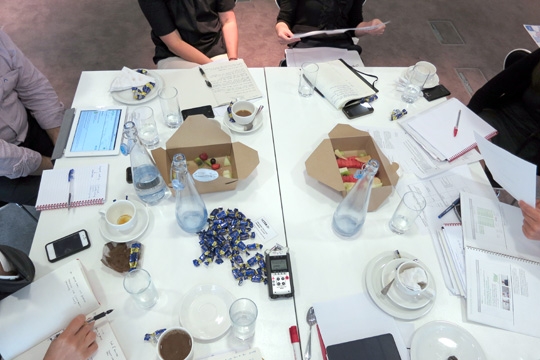
The 18 pages of dense notes in my sketchbook are testament to the caliber of conversation. Thanks to Philip Colligan, Katy Bentham, and Melani Oliver of Nesta; John Craig of Innovation Unit; and Hailey Brewer and Suzy Stone from IDEO. Many thanks also to Nesta for hosting the sessions, including a top notch picnic!
This took longer than it should have. We've been back from the summer holidays for a solid week now, but as you can see there is some lag getting back into the habit of writing.
Last time I was just heading to New York to meet up with Justin for our first of three HDL case study sessions. We had a very packed day with Rosanne Haggerty and her team from Community Solutions sharing their work in Brownsville and Rodrigo Araya and Alejandro Aravena reflecting on the reconstruction of Constitución. Justin and I are now processing those conversations and distilling it with the goal of writing two short case study papers.
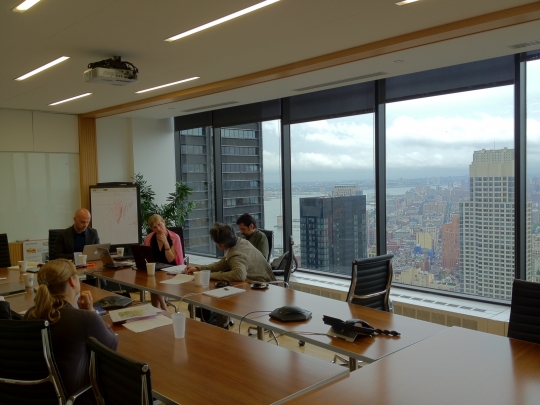
Monitor kindly loaned us one of their stunning conference rooms
On a meta level the session was instructive as well. Despite careful planning and logistics (and excellent facilities thanks to the Monitor Group), the agenda for the day was too ambitious. We spent more time on introductions and basic context than expected and felt the crush of the clock at the end of the day. In the next two sessions we are going to attempt to spend a day and a half total. Try, learn, adjust, repeat.
Next week Marco and I will zip to London to conduct the second (day and a half!) session, this time with Nesta and IDEO. Nesta are bringing their Creative Councils project and IDEO are going to share some work they've done with the US government. In other words, there's not a direct overlap in terms of content. Huh?
In organizing these case study sessions we've paired teams with slightly different content focuses as a way of ensuring that the conversation is about how innovation gets done. Our hypothesis was that by pairing up mismatched content the overall conversation would naturally veer towards the intersections between the two groups, the methods and approaches that they use to move forward. The first tentative evidence we have from the session in New York is that our hypothesis was correct: the conversation swayed back and forth between 'what' and 'how' but the room was most engaged and excited when discussing the practices rather than the specific details of poverty alleviation or urban planning.
With each case we're trying to understand the work on two levels: the 1:1000 high level overview and the 1:1 on the ground reality. The high level view is about getting the narrative of the project in order before we zoom in to look at specific important and instructive moments where something critical happened such as when funding was secured, where a key stakeholder gave their buy in, where the scope of the project changed, and so on. How did the project prepare for this, how did they weather it, and how—ultimately—did they come out the other side successfully? The impetus for this as a focus comes from a number of threads, but we can sum it up quite simply with a quotation from none other than the American boxer Mike Tyson:
Everyone has a plan until they get punched in the face.
Back here in Helsinki, our Brickstarter and Open Kitchen projects are revving up. We were very pleased to see a nice piece on Brickstarter on Wired.com last week and that gave up the impetus to do a bit of a press roundup.
Dan and I were in Kalasatama to meet with Antto and Elina about Open Kitchen. That is trending in the right direction and is about to get very busy. Next week we'll film a quick video as a Call for Applicants that should go public in early September. We want to make sure the eyes are dotted yadda-yadda-yadda before it all goes out the door, so more on this soon.
This year's Flow Festival features an installation by Nene Tsuboi and Åbäke depicting a number of unbuilt designers for Helsinki's Grilli kioskis, the city's hot dog stands. They asked me to contribute a micro manifesto about food and the street, to which I submitted the following. See also: Helsinki Street Eats and Dan's earlier piece for Artek's Manifest I. Lots of manifest(o)s.
The most visible food in the streets of Helsinki today has already passed through the human body and been reborn into the world as site specific installations of urine and temporary constructions of vomit. While we're a city that's comfortable with pissing in the street, eating is puzzlingly hidden. It's mostly reserved for the drunken stumble to a grilli (which everyone hopes to forget the next morning) and slurping porridge in a tori (where one is hidden amongst the ubiquitous orange tarps).
Despite Helsinki's architectural commentary by bodily function we have all the right ingredients for an urban culinary renaissance. In 2012 Nordic food is the envy of the world and Helsinki's specific architectural heritage gifts it a variety of iconic lippakioskis and grilli structures waiting to be linked into a city-wide network of grub hubs. If only they served something worth remembering.
Oh but they will! Bring on the curry siika, poro bratwurst, and birch soda. This is anything but a trend. It's a sign of a culture that embraces diversity, in a meal and on the street. Street food is about relearning how to make the city our own not just for occasional festivals but a real—and really delicious—part of everyday life.
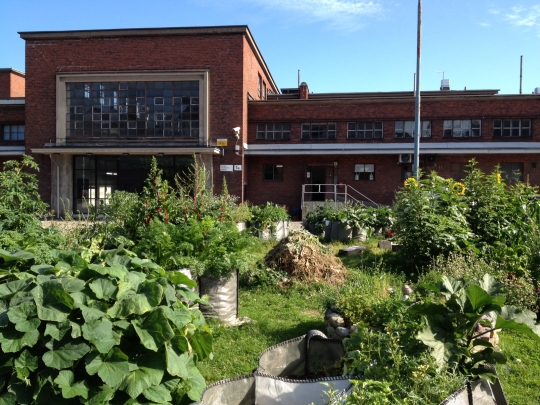
Tukkutori's edible garden is blooming very well in a series of grow bags. This will a great addition to Kalasatama when it's finished later this year.
In both Brickstarter and Open Kitchen we're increasingly turning our attention to how the projects will grow beyond Sitra. How far will we take the work? When do we look for partners to carry it forward? What does that handoff look like? This is a necessity of the work, on one hand, but we're also trying to use it as a point of innovation in and of itself. From the perspective of strategic design is there a different way to transition projects from in house to out of house, for instance? Early days on these thoughts.
Marco was quoted talking about Low2No and our Design Exchange Programme in the July issue of Wallpaper Magazine. They don't seem to have the article online, but the author has posted the full text on his blog. And speaking of Design Exchange, our second placement has started work at the Helsinki Department of Social Services. She will introduce herself soon on the DEP blog.
Juha Kronqvist is himself an embedded designer doing good work with a hospital in central Finland and Aalto University students. Recently he released this video that shows some of their paper ptototying of hospital spaces. You can also read more on their blog.
Lately we've been holding our project meetings in a construction site. The renovation of Sitra's 12th floor that we have been working on for a couple months now is finally complete. The space is light, bright, flexible. Personally I'm very happy with the way it has come together. It's definitely a step forward for our facilities and will take some getting used to, but the net effect is that we now have the kind of collaborative work environment that was hard to come by previously in the Sitra tower. Once people have settled in to the space we'll be posting some further thoughts on the relationship between workspaces and working cultures.
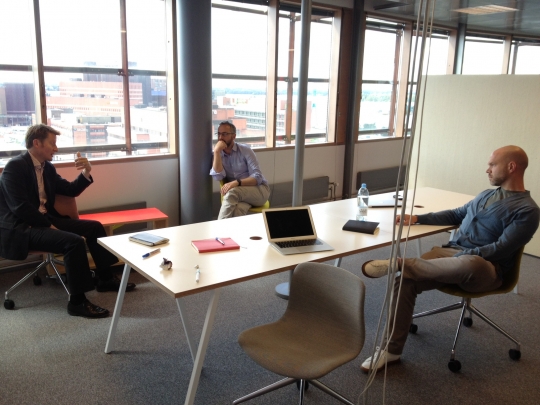
When this was taken there was still some electrical work to be done, as you can see
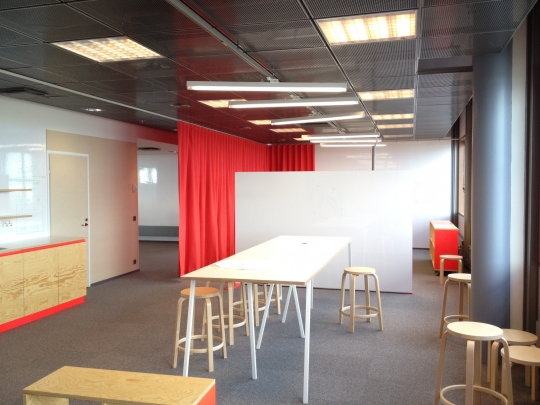
Our new kitchen, featuring an invisible coffee machine (until we get a new one)
Last but not least, if you are in Helsinki on Tuesday, August 14th you are very welcome to stop by the Paviljonki located between the Design and Architecture museums in Ullanlinna for a double whammy of strategic design.
Dan will be there to talk about his Strelka press book Dark Matter and Trojan Horses: A Strategic Design Vocabulary and I'll be sharing In Studio: Recipes for Systemic Change. Come have a coffee with us!
As I write this, my mind is a few days in the future, thinking about Friday at 9:30 when we will kick off "official" HDL 2012 activities. That's a rather serious-sounding way of saying that Justin and I will spend a day with six smart people in a nice room. Where HDL 2010 was about distilling a grand challenge into an actionable strategic intent, Helsinki Design Lab Global 2012 is…
about stewardship; or in other words, how innovative things get done. With the global conversation increasingly invoking the (re)design of systems, institutions, markets, and even the social contract, HDL 2012 is an opportunity to reflect upon the necessary innovation required of innovation itself. How do we shape policy through projects? How do we connect strategy to execution? How do ‘clients’ of innovation maximise their value and agency?
New practices, new themes, and even new vocabularies emerge as this community grows. Helsinki Design Lab 2012 is an opportunity to take stock of these emerging practices and begin to codify new ways of doing.
When we wrote the first three HDL case studies back in 2009-2010 we did so because the best innovators in the world rarely have the time to step back from their work and codify it in ways that others can make use of. And understandably, it takes time to reflect and then package those reflections, and that's time which can be used doing more good work! So beginning with those cases and now continuing with what we expect to be six more cases between now and October, we are using HDL 2012 to gain a deeper understanding of how innovation is accomplished by different cultures of decision making.
It's a comparative study of innovation practice, really. We've invited two public bodies, two NGOs, and two private entities to contribute one project each. Together these six practices span Europe, North America, and South America, and they work in areas ranging from community planning to business oversight.
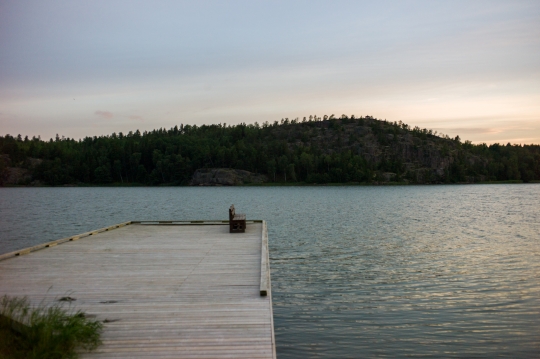
Summer in Åland, the archipelago between Sweden and Finland
The sheer diversity of the group was one of the things we were equivocal about for some time. A typical comparative study might seek to minimize the variables to down one—a range of public, private, and third sector organizations all addressing homelessness, for instance, and all in the same geography. But this year we will be juggling multiple variables that change from case to case, and the reason is rather straightforward: we have tried to recruit from the best of the best in public innovation, and that means accepting a more diverse set of projects. It would be crazy to assume that the best of contemporary practices are captured within any single field.
We're also experimenting a bit with the format. Rather than Sitra conducting one-on-one case studies, we're bringing together two cases at a time and asking the teams to help us interview and analyze their counterparts. This means that we'll have extra brain power in the room to ask the right questions and evoke the right discussion. Our hypothesis is that having practitioners interview practitioners will help us keep our heads out of the clouds. Someone who has been-there-done-that has a unique ability to stop things and ask questions like OK, but how did you really pull that off?
The kind folks at Monitor Group + Doblin have graciously loaned us one of their conference rooms (thanks especially to Helen Walters!) where we will spend the half the day discussing the reconstruction of Constitución, Chile after the 2010 earthquake and tsunami and half the day focusing on the revitalization of Brownsville, NY. Alejandro Aravena and Rodrigo Araya will be sharing their experience with the work in Chile and Rosanne Haggerty will be joined by a number of people from her team on The Brownsville Partnership. We're lucky to have been following their work for a while, and personally I'm looking forward to getting a good chunk of time to understand their recent efforts in depth.
Friday will be the first of three case sessions leading up to a culminating event in Helsinki in mid-October. It's going to be a small affair with only about forty people, but as always we will do our best to make sure that the learnings are shared as widely as possible.
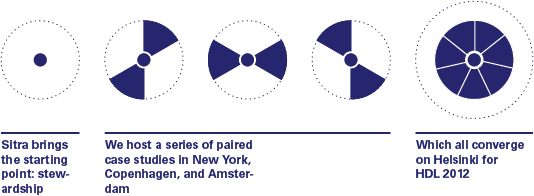
Outside of the intensifying work on HDL 2012, I've been hosting the occasional group for a talk at Sitra (thanks for coming, EGOS) and working on some back burner projects (more on those in a second). Kalle is in the office tending to our food work which now has the beginnings of a web presence. Marco, Dan, Justin, and Maija are enjoying various depths of the summer holiday.
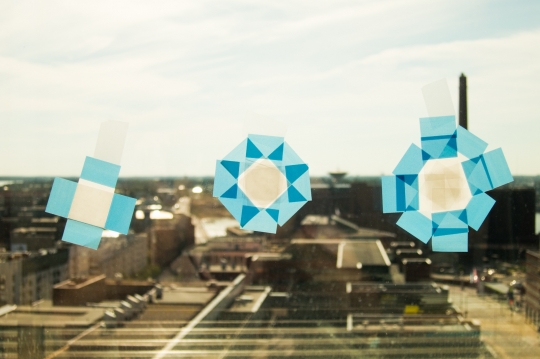
Clear evidence that Marco has been in the office, and so have his kids.
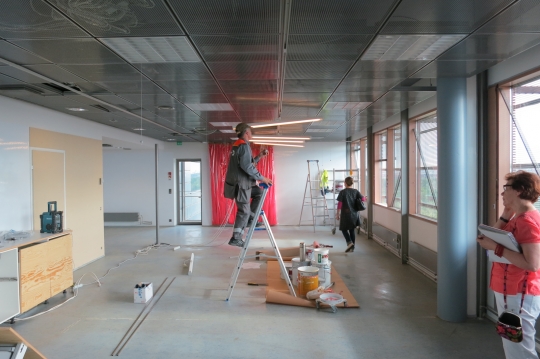
The renovation project we've been working on in the office continues to inch forward. I'm looking forward to this being done.
At the risk of making us sound obsessed with codification, I've been taking advantage of the slow pace of the office in summer to revive a long overlooked "manual for creative collaboration." We had the opportunity a couple years ago (!!!) to commission the Open-Ended Group to write a pamphlet on how to get the most out of collaborative work, but we've been so busy with everything else that it's only now that I've found the time to open those files again. It's good, simple, clear text and I've allowed myself the indulgence of devoting time to experiment a bit with the layout, taking inspiration from the lovely Bauhaus typography I saw at the Barbican in London recently. Eventually this will sit alongside the Design Ethnography field guide as a small practical manual.
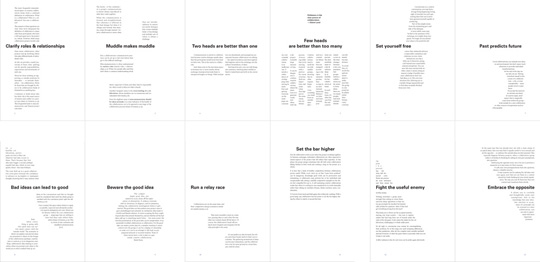
Draft layouts of the collaboration booklet.
After spending two extremely intense days in Copenhagen with a group of people running various "design labs" at the beginning of the month, I'm once again struck by how much shared territory there is in the various approaches, and yet such significant differences in the way that different groups describe their work. That these practices are being cobbled together from a combination of social science, design, media, entrepreneurship, public administration, and other backgrounds means that a common ground doesn't come naturally but must be willfully created. The lack of shared vocabulary makes the true overlaps harder to see and positive differences harder to highlight.
Take "participation," for instance. Different groups use the term "participation" variously to mean working with people to create novel ideas, conduct due diligence on proposals, or secure wider buy-in for a course of action—and sometimes a combination of these. But those are three very different ways to use "a bunch of people in a room doing something together," each with their own nuances, pitfalls, and benefits. No wonder Markus Miessen refers to the Nightmare of Participation!
Thanks to Banny Banerjee, Christian Bason, Tim Brodhead, Luigi Ferrara, Sam Laban, Cheryl Rose, Frances Westley for the generous discussion. There will be a summary paper coming from that meeting which we'll post here when it's available.
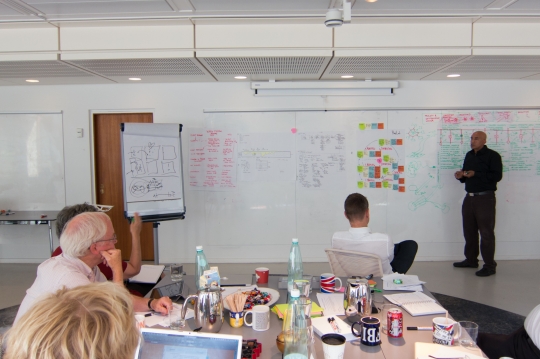
Banny explaining the Stanford d.School design process.

There's a CNC fabrication shop in that basement. Copenhagen knows how to make a courtyard.
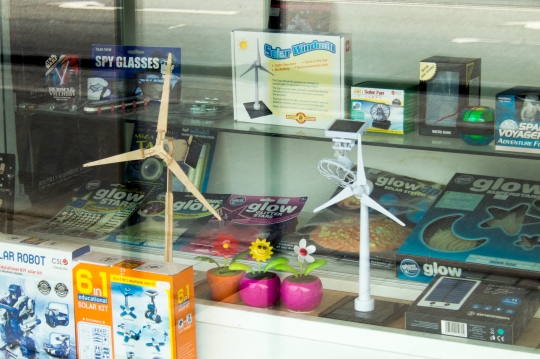
That you can buy mini turbines at a toy shop in Copenhagen says a lot about deeply renewable energy has soaked into Danish culture.
For a final and more entertaining note on collaboration, codification, and getting things done, I leave you with this video introduction for new employees of New York-based artist Tom Sachs' studio.
Summer was here, but then it left. We're back to gray and rainy skies. This has given me license to indulge, temporarily, some of the more arcane reaches of our team discourse. It starts here:
We talk a lot about dark matter because it's the focus of our work, really. But the problem with dark matter is that you can't see it and you can't detect it by definition. It's out there shaping the things we can see, but dark matter itself is known to us only by virtue of the effects it creates. Since we can't see the thing, those effects crop up at unexpected moments and in unexpected ways.
This means we need instruments that help us flesh it out, ones that show us the shape of the dark matter, and reveal its boundaries. If we were physicists we would be building space probes, but since we're not we make projects. For the strategic designer, a project (making a thing or interaction) becomes a way to flesh out the unknowns.
Or if we borrow from Joi Ito again, doing projects is often a cheaper way of identifying needs and innovation opportunities than it would be to analyze a situation. So that booklet floating in space becomes this...
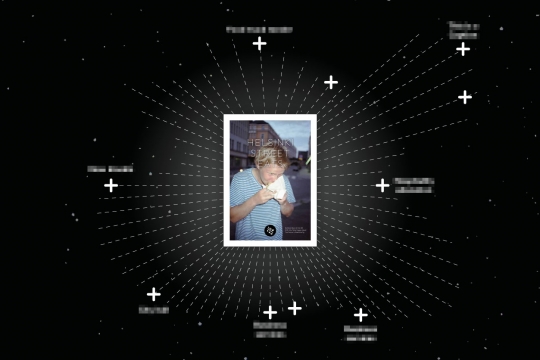
Names blurred out, for the moment
...a token that's launched into as many situations as possible, to bump into as many edges as possible, and eventually send back details of its voyage. Now that our food booklet has been floating around the city for a few months we're building up a decent understanding of the situations it has ended up in—and hopefully the dots it is connecting. It's not the only tool we use, of course. We're also in regular meetings with various stakeholders. But that's the point: the probe/project takes on its own life.
This is (slowly) leading to two bodies of work: one within other institutions, where Sitra can act as a neutral host for shared discussions and decisions. Another in the community, where we hope to be announcing a programme in September which will offer a way around some of the blockages and knotty bits that our space probe has sent us details of.
So, yes, we obsess over the documents, websites, spaces, and other things we're stewarding into the world, but those details are not the source of our motivation nor the locus of ambition.
Some examples:
- 12 floor renovation: enabling a new culture of collaboration at Sitra
- Food booklet: mapping out the diverse field of 'owners' of food business and bureaucracy in Helsinki... helping us define the opportunity space
- Brickstarter as a product: creating concrete discussions about frictions existing in the regulatory & financial sectors and increasing community know-how around civic entrepreneurship
Speaking of Brickstarter, things continue apace. Maija has been doing a good bit of research on other crowdfunding and crowdsourcing initiatives, for example the Avoin Ministeriö or "open parliament" which is set up to receive suggestions for new laws. This is the first in a series of 10-20 summaries of relevant efforts from Finland and elsewhere.
It's great to have an expanded team and the impact of Maija and Kalle is already starting to show.
Marco spent the better part of an afternoon with Sara from the Design Exchange Programme, talking through the strategy for the next couple months. He was also working with the Helsinki Department of Social Services to finalize the selection for the exchangee who will begin working there in August. We'll reveal the name of that lucky individual after the summer holiday.
From his homebase in Boston, Justin has been contributing to the ongoing development of Sitra's sustainable economy thematic area which is under 'construction' at the moment. He has also been in talks with a Boston-based group who's interested in utilizing the Studio model.
On that front, we're officially done with the first edition of 1000 copies and the second edition has arrived. There are some small tweaks, of which my favorite is an adjustment to the page edges in the appendix so it's easier to flip to the each of the individual challenge briefings. There are other minute changes throughout such that if the book had a version number this would be 1.1. We're going to try to get some copies up on Amazon for those of you who've mailed asking about how to get a physical copy.
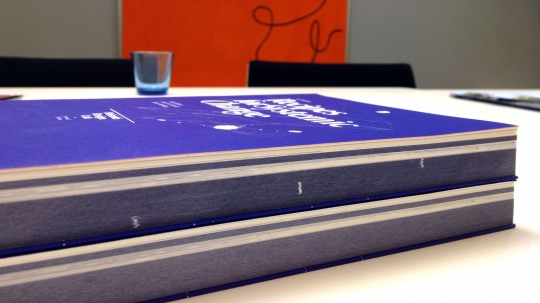
New on top, with the vertical lines making each of the three challenge briefings. Old on bottom.
Otherwise: on the horn with Chicago, Geneva, San Francisco, and London. Partially for HDL 2012 prep but also for other assorted bits.
With July hitting next week we're a bit in scramble mode. Finland more or less shuts down completely for the month, which is both amazing and maddening. If you're on holiday it's great. If you're not, it can be a big impediment to getting work done. One of the open questions for us is whether the renovation of our 12th floor, a project which Dan and I have been spearheading, will actually be completed before our target of August 1.

Scenes from a recent meeting on the building site
A strategic design challenge of significant difficulty: convince the Nordics to split their holiday month into shifts so that no more than half a country is away for 2-6 weeks at any given moment.
Right. While some bright young designer is figuring that out, we'll be in various states of holiday! During the next month or so updates will likely dwindle but Maija, Kalle, and I will be holding the fort down while Marco, Justin, and Dan enjoy some well-earned time off.
Hyvää kesää kaikille!
And another two-for-one, which illustrates a) that we're busy, which is good, and b) that for many of us, holidays are approaching rapidly, like a broad sweep of clear blue sky appearing on the horizon, which is also good.
Summer is here, by the way.
After giving a talk at the European Centre for Living Technology in Venice, Bryan then took the opportunity of being in Italy for a quick well-earned break featuring la dolce vita, I believe. ECLT seem to be doing some really interesting work regarding "economically viable"/sustainable mountain communities in Italy—definitely worth a look, according to Bryan. Meanwhile, Marco and Justin have been knee-deep in Low2No as usual, partly working on this aspect, amongst other things. And Maija Oksanen has joined us too, as a summer intern. With Kalle, we now have a fuller team, and thankfully some more native Finnish speakers. That is already helping us hugely, though Maija and Kalle bring a lot more than just their exemplary language skills.

Part of team SDU, now featuring interns.
In the last few weeks I've been to Milan, London, and Amsterdam. Oh and I had to unfortunately cancel a trip to Moscow, which is probably just as well given that diary. (But still, Russian visa timelines! Why, in this day and age, is it still so difficult for non-Russians to do business in Russia? Legacy dark matter.) I'm sorry not to have made it to Moscow, but these trips are always a whirl of talks, lectures, meetings, logistics, and brief, stolen moments of peace and reflection amidst the bustle of these fine, old cities.
The Russia trip was to be a talk at Strelka Institute, which I'm hoping to be able to do later in the (northern) summer. Strelka are one of the more interesting design schools in Europe at the moment. They also happen to have recently released the essay I wrote about six months ago (Bryan referred to it last time): "Trojan Horses & Dark Matter: A Strategic Design Vocabulary."
This is part of the new Strelka Press series, curated by Justin McGuirk, which features other essays by the likes of Owen Hatherley, Sam Jacob, Keller Easterling, Julia Lovell and Alexandra Lange, as well as Justin himself. It's an interesting approach, exploring the e-book format for essay-length writing, and priced at a level that makes it accessible to a wide audience.
My essay covers a lot of the terms, and background conversations and thinking, that underpin some of the things we've been writing about — and more importantly, trying to get done. It's intended to be a kind of primer, or "playbook", which presents the idea of a vocabulary - as a way of starting and developing conversations in this new area. With that in mind, please do let me/us know what you think.
The other trips were to the Politecnico di Milano's architecture summer school for a talk, but with a short hop over to Frog Design Milano to discuss strategic design with them. Also, Joseph Grima of Domus magazine, to talk Istanbul Design Biennale amongst other things.

Milano Frogs, about to get a talking to.
London was more of a meeting-based trip, featuring a catch-up with the indefatigable Tom Loosemore, an old colleague from BBC days, who is now doing great things at Government Digital Services, which is part of the UK Cabinet Office (we mentioned their design principles previously). They, too, are going well beyond "this is just a website" work. Also, a useful catch-up with Philip Colligan and Laura Bunt at our sister organisation NESTA RE Helsinki Design Lab 2012, and a good chat with Laura afterwards. Plus a meeting with Gill Ereaut of Linguistic Landscapes, who do fascinating work working with organisations (often public sector) to understand and unpick their habitual behaviours through the prism of their everyday working language.
I also met up with Ricky Burdett of the London School of Economics 'Cities' programme. Burdett is a hugely influential figure in the field of urbanism and cities generally, so it was a pleasure and privilege to meet him. It looks like we'll be working together on a new LSE Cities conference in London at the end of the year, where I'll be talking Brickstarter and beyond, hopefully, in the context of "smart" and "not so smart" cities.
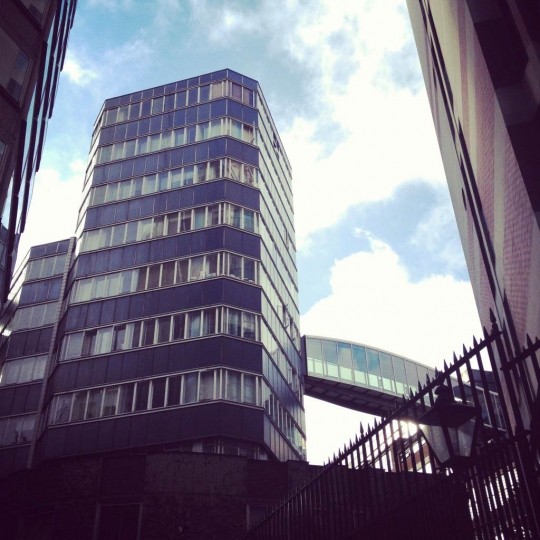
Visiting the London School of Economics
Ricky and I are also on the advisory board - with Sir Peter Hall and Saskia Sassen - for a new Young Foundation project called "The Social Life of Cities", in association with Cisco. We had a first meeting of that last week, for which I had to endure a visit to a terrible business park in Espoo. The irony of being there - virtually alone, surrounded by concrete flyovers and lazy, ugly, damaging buildings - and yet talking about "the social life of cities" was not lost on me. Perhaps it's useful research just to be there! Still, the project could be very valuable and we got off to a good start with an engaging discussion.
Back in London, I spent a long but enjoyable day at BERG London, judging the Core77 Interaction Design awards, with Bonnier's Sara Öhrvall, BBC's Julia Whitney and BERG principals Matt Jones, Jack Schulze and Matt Webb. Results out in July.
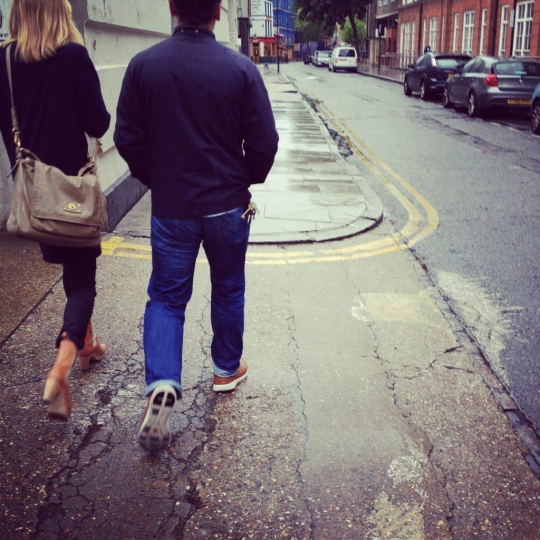
Sara Öhrvall & Matt Jones, breaking for lunch.
While at BERG's studio, Sara and I were addressed by a certain Little Printer.

Little Printer's little print-out.
Finally, Amsterdam was a speech at the start of the 'kennisdag' (knowledge day) for the 500 staff of the City of Amsterdam's "spatial sector" (architects, planners, engineers, real estate etc.) The City had lined up a very impressive day of workshops for their staff, all held at the wonderful Felix Meritus building on beautiful Keizergracht. It was great to see a city government actively working at shared thinking and discussion, particularly given the challenges all city governments are beginning to face (and so the Brickstarter work was again germane to their thinking.)
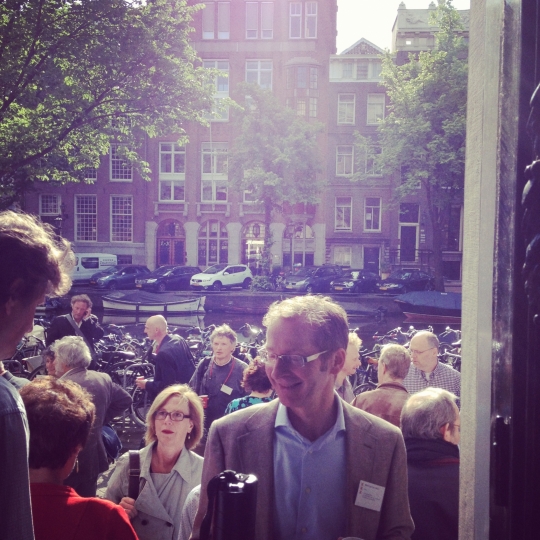
City of Amsterdam folk, arriving for the "kennisdag".
For Brickstarter, we brought energy policy expert Robert Brückmann (of Eclarion) over from Berlin, to talk to Sitra and a few other representatives from relevant sectors in Finland. We had a great discussion about Germany's energiewunder - also discussed previously here. Again, we are hugely inspirted by what Germany have done here. This follows previous Brickstarter talks from Marcus Westbury and Rodrigo Araya, and more to follow after the summer break.
We'll have some major updates on Brickstarter.org shortly. I've been handling the stewarding of a clickable prototype "conversation starter", and that will soon be up. Maija has been plugging away researching 'adjacent' services. Expect to see lots of little 'fact card'-like blog posts up there soon. Kalle has also been developing some similar 'fact cards' around food scenes in cities - focusing on the legislative environment (dark matter), rather than cuisine as such - for use in our food-related projects. (Just after that, Kalle, who is a barista, headed off to Vienna for the World Cup Tasters Championships, where he placed ninth. Amazing. Well done Kalle!)
That food work is progressing rapidly now, in partnership with Antto Melasniemi & Elina Forss, as well as the City of Helsinki (Ville Relander) and will soon be appearing on its own project blog.
We'll also give you an update regarding our Design Exchange project shortly, which has been progressing nicely in Lahti, as well as our renovations and reworkings of the Sitra tower.
Meanwhile, it seems that every other week we're discussing what we do with representatives of various pioneering Canadian social innovation organisations and foundations - they seem like they are on the brink of becoming the most fertile place for that kind of work, interestingly. A couple of weeks ago, Bryan had a chat with Lisa Tjorman, of the aforementioned excellent Labs report, and last week, we were happy to discuss our work with Allyson Hewitt, also of Social Innovation Generation in Toronto. Watch that space, is all I'll say for now, but they're heading somewhere very interesting over there …
And finally, as they say at the end of British news broadcasts, we're spending a lot of time on internal culture, and particularly the notion of "ideas", "projects" and the relationship between those things. Which, of course, is not always self-evident, or simple.
With that in mind, Bryan forwarded on this post from Adam Mathes, formerly a product manager at Google, about his practice:
My conclusion after a few years is that the best product management is about providing the vision of what to build and why and then creating the context where great things can be made. That context usually involves the right people, space, time, and patience...
But for truly innovative and creative products, project management may not matter as much. If you are making something new and creative and different, it’s hard to know exactly how to make it. You may be building the tools and technology you need because they don’t exist yet. And may be impossible to properly estimate how long it will all take.
More on Adam's blog.
And finally and finally, we spied our "In Studio" book on John Thackara's bookshelf in the lovely "virtual tour" of his workspace recently posted. It's apparently creeping its way towards him, day by day. As it should you.
Another newcomer reporting! My name is Maija and I just joined the Strategic Design Unit as an intern. Originally from Finland, I’m currently enrolled in a Master’s course in Gothenburg, Sweden. I study at the University of Gothenburg in a program called Business & Design. The two-year program is a joint venture between HDK (the School of Design and Crafts) and the School of Economics and focuses on working with design strategically within organisations. After finishing the first year I’m joining Sitra for a semester as a part of my studies.
My background is in the field of culture, literature and the arts and I’ve been working with arts management as well as event production both in non- and for-profit organisations. I’m looking forward to an interesting time here at Sitra; already my first day has been quite a ride!
Aside from work I plan to enjoy the Finnish summer and you’ll most likely find me sailing in the archipelago or enjoying the quietness of our summer house by the sea. I am a Finn, after all.
Ha det bra!
